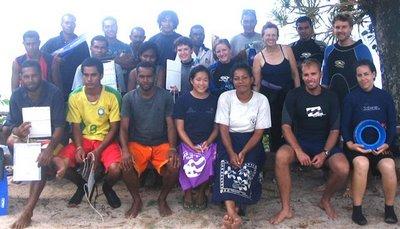
February came and it was time again for the
Marine Ecology team to head out to
Waitabu village for their annual biological monitoring of the Waitabu Marine Park.
This year’s survey was both fun and quite successful. Despite the slightly few wet days at the beginning of the week, spirits remained alive through the week and we completed all surveys as per schedule.
Helen and I were joined by Rosemary Dautei from
Reef Safari’s, Rachel Dacks, Nic Turrentine, Natalie Parker, John Leonard, Leslie Currie and Grace Yeung (posted in the village) of Peace Corps Fiji. To be part of the week long activities was an experience for them and an opportunity for us to exchange ideas and share experiences.
The village team of 11 volunteers were disciplined; excellent surveyors who definitely knew their stuff. Together we made a really dynamic team out of the
Peace Corps, village surveyors and me, most of the time making sure we were doing it right. All this went on while Helen counted fish and saw to other matters of importance to the camp ground, village and home-stays.
 2009 Waitabu Survey team
2009 Waitabu Survey team Back Row: Joe Saro (Boat captain), Grace Yeung (PC), Rose (RS), Tiko, Leslie (PC), John (PC), Natalie (PC), Nic (PC), Rachel (PC), Paulo.
Middle Row: Kelepi, Chin (MEC), Eta (Park Manager), Paulo W.
Front Row: Lari & Okostino
(Note: PC =
Peace Corps, RS =
Reef Safaris, ME =
Marine Ecology Consulting)
Sunday 01 - Feb 2009 My week began with the village children the Sunday afternoon I arrived in
Waitabu. Thirty seven kids took part in a three hour marine education and conservation program. Children from as young as 3 to 15 years participated in the introductory marine education lesson, drawing and coloring in of the poster “Sasalu ni
Waitabu” which translates into
Waitabu’s reef resources. Positive responses were received from the children and at the end of the program they were all shouting “na lase e manumanu” meaning coral is an animal. Even if these kids got in only as much is satisfactory for me as many young and adults in Fiji are still unaware of this fact.
Community children participating in marine education activity WaitabuKids
WaitabuKids Child busy drawing reef resourced.
Child busy drawing reef resourced.
 Dad Pita with 3yr old Sala busy coloring. Monday 02 – Saturday 07 Feb 2009
Dad Pita with 3yr old Sala busy coloring. Monday 02 – Saturday 07 Feb 2009The mornings began with a complete breakfast (most of the time) of fruits either Avocado pears (brought by Rose) papayas or banana’s (from the farm), Helen’s Mainland Vintage cheese, FMF breakfast crackers with either drau-ni-moli or Punjas tea. (Recommended field breakfast for reef surveyors in Fiji)
The biological surveys began on a wet Monday morning with the Manta Tow in the Marine Park.
Being dragged behind a boat is certainly a lot of fun but not when it’s raining and the water cold.
We rounded up for the day completing the “Cawaki” (edible sea urchins) survey in the Marine Park and the fishing grounds.
 Manta Tow in Marine Protected Area
Manta Tow in Marine Protected Area
A refresher
Reef Check training was conducted on Tuesday morning before we went out for the Giant Clam (Vasua) survey in the
Marine Park and Trochus (Vivili) survey in the
Marine Park and the fishing grounds.
Practice
Reef Check surveys were first carried out in the Rara (village green) and then in the fishing grounds on Wednesday morning to make sure everyone understood and knew what they were recording.
Reef Check surveys were conducted in the fishing ground flats and at the reef edge after lunch on Wednesday.
We had what we call perfect
Waitabu morning when we woke up on Thursday. I had the opportunity to see the rising sun lying inside my tent (luxury!!!). The mountains behind the village glowed orange as the sun came up and the lingering smell of burning wood from the open fire kitchens in the village will be etched in my memory for years.
[div class="s